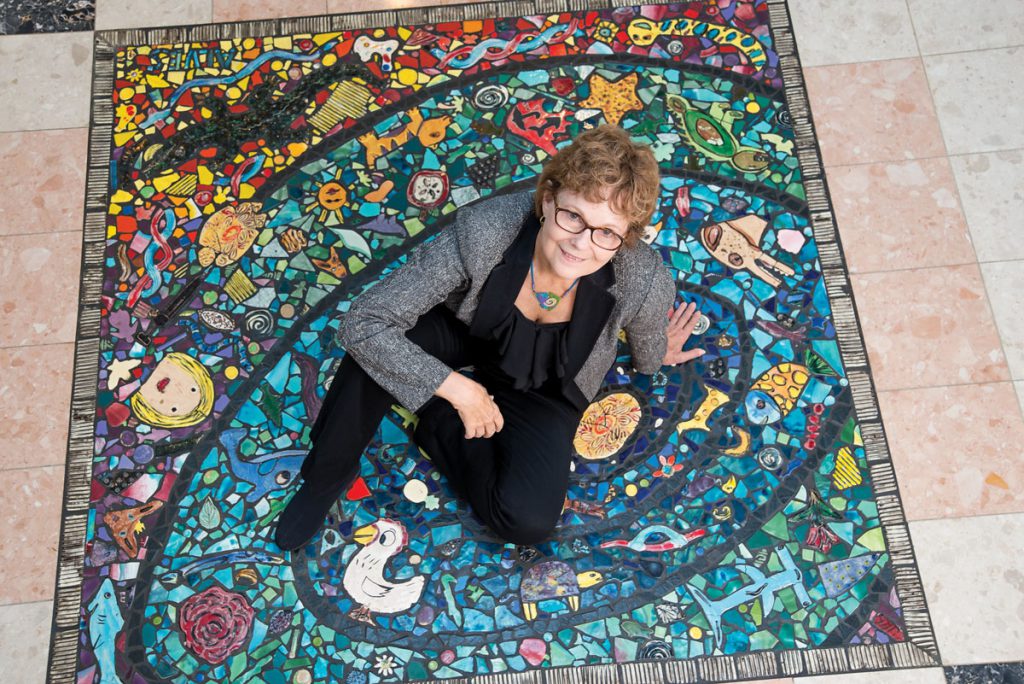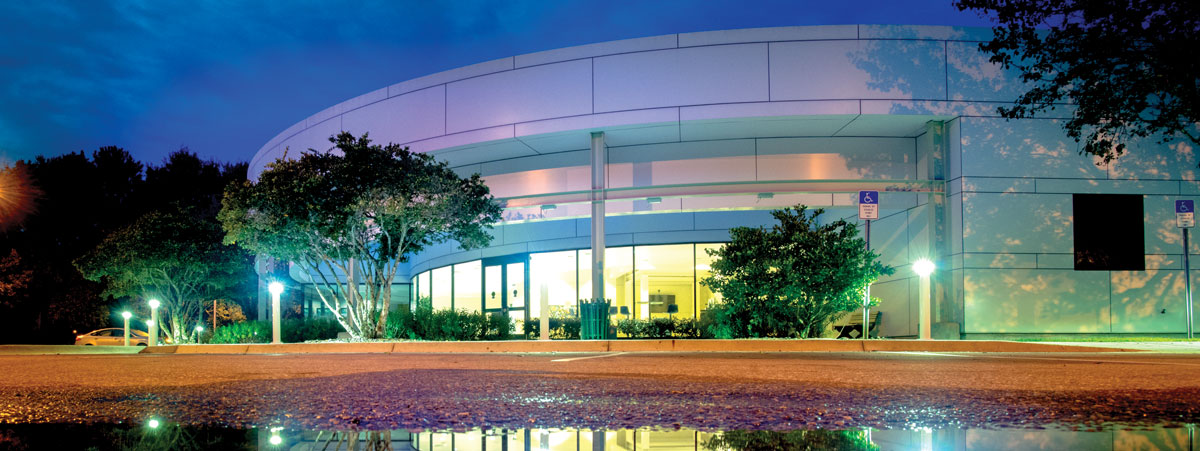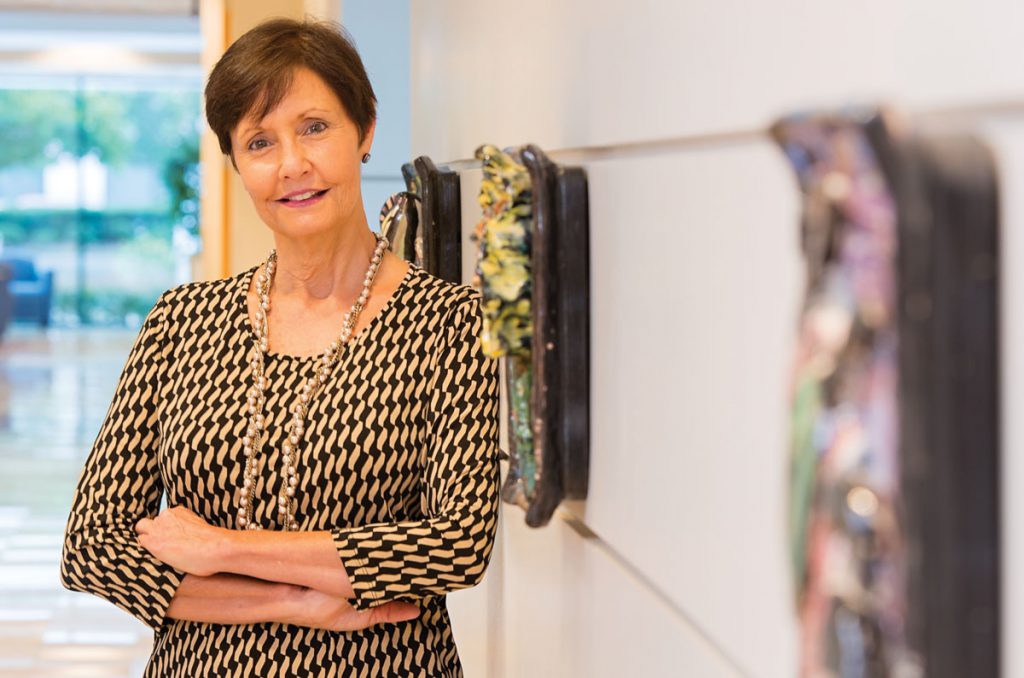When Merrie Shaw was working on her science fair project on nematodes in sixth grade, the topic resonated with her because the pests were a problem for her family’s Alachua farm. Spraying pesticides meant leaving the land fallow for six months to let the toxic pesticides wear off before replanting.
Shaw grew up and left home, but when she returned 30 years later she found someone else working on her sixth-grade science fair project: Pasteuria Bioscience.
“I remember that jar of nematodes, and now all of sudden, someone can actually treat nematodes, and it’s a green formula, and it’s safe, and it doesn’t harm crops,” says Shaw, who has a front-row seat for bioscience success stories as manager of the University of Florida’s Sid Martin Biotechnology Incubator. “When I left, this was all a cow pasture. I got back, and wow, it’s a biotech center.”
When the incubator opened in Progress Park in 1995, it was a risky venture. The incubator idea was still new and bioscience incubators were rare. This year, the incubator celebrates its 20th anniversary ranked among the world’s best. But like its fledgling businesses, incubator leaders had to work hard to build a foundation for success.
Director Patti Breedlove has watched 17 years of development and, much as the incubator shepherds its start-ups, Breedlove has shepherded the incubator, making it one of the most sought-after sites for a biotech start-up, with more applications than it can accept.
“In very recent years, I think we can say our ambitions have been realized,” says Breedlove. “Just in the last four years, we’ve had some significant events with our companies.”
That may be an understatement.
- Pasteuria Bioscience and its environmentally safe nematode control was acquired by global agricultural giant Syngenta for $113 million.
- Nanotherapeutics, a pioneer in drug bioavailability, landed a $358 million Department of Defense contract and is building a 180,000-square-foot building next to Progress Park.
- AGTC, a gene therapy developer, has products in phase II clinical trials and attracted $88 million in venture funding before a $52 million IPO last year, when it joined the NASDAQ. It also is moving into a new headquarters and has announced a collaboration with biotechnology pioneer Biogen that could become the first billion-dollar deal for a UF spinoff, if all options are triggered. (For more, see timeline)
The excitement didn’t end there. The incubator has won four international and national first place awards or rankings in that time frame, including world’s best incubator in 2013.
“It does seem to have blossomed recently,” Breedlove says.
Although Breedlove is quick to brag on the companies, she could as easily brag on the incubator’s impact: Sid Martin companies have attracted more than $1.3 billion in funding and created more than 2,000 high-wage jobs.
The success seems sudden to outsiders, but Breedlove says it springs from a lot of activity under the radar and a lot of early lessons. Along the way, incubator leaders have learned how to create an intimate environment within a huge research university to foster the business of science.
Lessons Learned
Randy Scott remembers the early days, when Progress Park had the incubator and one other building, where his company, NovaMin, was located. Scott jokes that “back in the day when we were all starving” more money changed hands at the standing poker game between incubator and Progress Park tenants than in business conducted. As an incubator neighbor, he says he benefitted from the collegial atmosphere, and he says the first venture capital investment for NovaMin came through an introduction Breedlove made.
The stakes at that poker game likely would be higher today. NovaMin was bought by an international conglomerate and Scott is now a partner in HealthQuest, a venture capital firm, as well as a mentor to a new generation of entrepreneurs.
Weaver Gaines, the incubator’s first tenant as a founder of Ixion Biotechnology, says the incubator environment created a brain trust to tap into.
“When you gather people facing the same problems you are, there is always somebody around the corner who can help,” says Gaines, who is applying his business acumen to a new company, OBMedical, in Newberry. “The very existence of a node connecting people doing the same things operationally is irreplaceable.”
Gaines was a member of the founding group that set up the guidelines for the incubator, including the critical question, “When do you hatch?”
Ixion was one of the first two graduates, and although it succeeded, Gaines says it probably was not quite ready to “hatch.” Breedlove says that is one of the early lessons incubator managers learned.
Initially, companies could only stay three years before they were “force graduated,” Breedlove says. That was a typical incubation period for traditional companies, but she and her colleagues realized that biotech companies are different. Because of clinical trials and the approval process mandated by the U.S. Food and Drug Administration, among other hurdles, biobusinesses can take more than 10 years on average to get a product to market.
Forcing a company out too soon can lead it into a “valley of death,” after early-stage investments have been spent and before real sales revenues start flowing, where the company can wither and die.
Today, the incubator has a policy of one-year renewable terms for clients, with a formal review each year to see if a company has made enough progress to stay another year. The process is open-ended, case-by-case, because each company has a different time frame for maturity.
“We can’t be naïve, they’re not all going to be stars, some of them have to fail,” Breedlove says. “Our willingness to make those hard calls is one of the reasons we’ve been successful.”
Incubator manager Shaw says about 86 percent of the incubator’s clients are viable five years after graduating. Of the 53 companies admitted, the average stay is 5.5 years, but sometimes circumstances create longer stays. Pasteuria, for example, is still in-house, waiting on its new space. When it leaves, Shaw says, that could relieve the logjam on the waiting list, creating space for more start-ups.
Interestingly, Breedlove says, the most successful companies are those which have stayed the longest.
“Unlike apps and software companies, biotech companies take years and years to get to market,” Breedlove says. “They have long childhoods.”
Parting ways with a company that is not making it is tough, especially when Breedlove and the staff are rooting so hard for them.

“This goes beyond business success,” Breedlove says. “These companies are working on things that can really make a big difference in the world, whether it’s for patients or for the planet.”
Breedlove had one of those hard conversations recently with a company, whose CEO told her, “I hope I get good enough to come back.”
In addition to like-minded individuals with whom to share ideas, the incubator offers more than $1 million of shared scientific equipment, wet labs, ultra-low-temperature freezers, greenhouses and animal facilities. Without this common equipment, Shaw says, many start-ups would not be viable.
“An autoclave can be $80,000, and if you’re surviving on a grant, that goes fast,” Shaw says. “Here, the monthly fee covers everything but phones, and they know what to expect.”
From Tenants to Neighbors
Companies that graduate need something that is in short supply in Gainesville: biotech lab space.
For some, that’s not a problem; with success comes resources. Gaines, who is still active in Nanotherapeutics, points out that the company had taken over all of one building at Progress Park and quickly needed space again. It decided to build a 180,000-square-foot complex next to Progress Park, staying close to its roots.
AGTC, too, can afford space, and will become the anchor tenant in the first, 42,000-square-foot building going up across U.S. 441 in Foundation Park. Developer Brian Crawford, of Concept Companies, says the park will fill a critical need in Alachua County for space specifically configured for biotech companies, who can’t just leave the incubator and move to a typical office park. The need for wet labs and accommodations for scientific equipment makes biotech space about twice as costly as typical office space.
In addition to wet lab space, Gaines says the biotech community needs better access to capital and better management, and “the incubator helps us attract those things.”
Success also seems to beget success: Coqui RadioPharmaceuticals recently announced it will build a $250 million medical isotope manufacturing plant next to Progress Park, in part to capitalize on the spirit of innovation in
the area.
“This is a highly educated community that attracts the creative class,” Breedlove says. “In the past, we’ve grown our own businesses, almost exclusively. In the future, I think we’ll start attracting companies from the outside that like what they see here. Our cluster here in Alachua is already large enough to attract people and retain companies. We’ve created ‘stickiness.’
“It’s beneficial to keep our companies here for the synergy,” Breedlove says.
In addition to Foundation Park, UF still has land for expansion, so the burgeoning biotechnology community seems likely to keep growing. Breedlove says UF’s science is a common thread, with many companies depending on UF’s Office of Technology Licensing to get from the point of discovery to the marketplace.
“For the incubator to be successful, that process has to work well, and it does at the University of Florida,” Breedlove says.
David Day, assistant vice president and director of the Office of Technology Licensing, assumed responsibility for the incubator in 2003 and instituted some changes aimed at making it more attractive to venture capitalists.
“We courted experienced entrepreneurs and investors,” Day says. “We rebuilt the incubator’s advisory committee with investors not academics, and listened to them.”
Breedlove sees a bright future and ways to get even better. In the years ahead, she’d like to see a building for phase-two companies.
“Even after six or seven or eight — even 10 — years, a biotech company that is going through the FDA is still quite young, quite vulnerable,” Breedlove says. “They may not need all the resources of the incubation program, but it’s difficult for them to find the right lab space, so a building for those companies would be valuable. Otherwise, we could lose them.”
Breedlove looks back as she prepares to hand over the reins after her December retirement.
“We wouldn’t be here without the visionary thinkers at the University of Florida in the mid-1990s who created this program when really there was no role model for biotechnology incubation,” Breedlove says. “They gave us everything we needed to be a successful program.”
Related Website:
This article was originally featured in the Fall 2015 issue of Explore Magazine.


